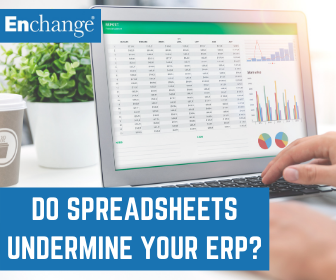Despite what you may wish to believe the answer is almost certainly, yes. You have invested heavily in brand new ERP software and a similar investment in some smart, young consultancy people to run the implementation. You will have spent some considerable time debating and making these choices as the change to an all-encompassing and integrated ERP is a huge step. At the same time, this change presents a huge risk for you and your company.
 No doubt after much heart and brain ache plus seemingly endless long hours, the new ERP go live actually happens. Suddenly the flexibility to back-date or correct entries is lost or at least there is a rigid and auditable procedure to follow in order to make any adjustments. Sudden uplifts in sales cannot be slipped in unnoticed after month-end and neither can supply shortages or marketing tardiness with promotional activity be hidden. Everything you do in a good ERP is recorded, date-stamped and forever auditable.
No doubt after much heart and brain ache plus seemingly endless long hours, the new ERP go live actually happens. Suddenly the flexibility to back-date or correct entries is lost or at least there is a rigid and auditable procedure to follow in order to make any adjustments. Sudden uplifts in sales cannot be slipped in unnoticed after month-end and neither can supply shortages or marketing tardiness with promotional activity be hidden. Everything you do in a good ERP is recorded, date-stamped and forever auditable.
If your ERP really is the only software being used to run your business then you deserve a pat on the back and a hearty well done. However, in a surprisingly large number of companies the all-important role of change management has not received the required seniority or focus, if at all. Staff who have been using spreadsheets for maybe 10 - 15 or more years (it was released in 1985!) cannot and will not stop using them just because they have been trained in a new ERP. Spreadsheets are like a teddy bear and hot chocolate at bedtime; they are familiar, comforting, not demanding and always there!
An element of your decision to implement a new ERP was probably a supplier guarantee that people productivity and data/information accuracy would be improved. As ever, the output is directly related to the quality of the input and a new ERP is not going to cure your master data failings. In reality you will find staff operating a covert shadow ERP on the same old spreadsheets. Detailed planning, sales and allocation decisions are being made on spreadsheets and then manually inserted into ERPs. Commonly, decisions are taken in isolation of S&OP and lack the consistency that ERP master data control allows plus the all-important history development for the business baseline.
Staff efficiency and data accuracy have certainly not improved; they have worsened. The tedious “cut and paste” of data into the ERP is time consuming and fraught with error. Post ERP implementation is always a rough time for businesses as they get to grips with a new way of working but is it any wonder some stay in a continual state of catatonic intensive care?
If you pay sufficient attention to change management before you press the green button on a new ERP you can lessen the impact. Should staff not see the medium/long term benefits outweighing the short term inconvenience then they will continue operate the covert ERP, i.e. Excel. The change manager has to clearly show what the ERP brings to people first and subsequently the company – not the other way around.
Of course, one solution might be to deactivate the spread sheet program on the corporate network until ERP discipline is second nature. Now, who is brave enough to take that momentous decision?







